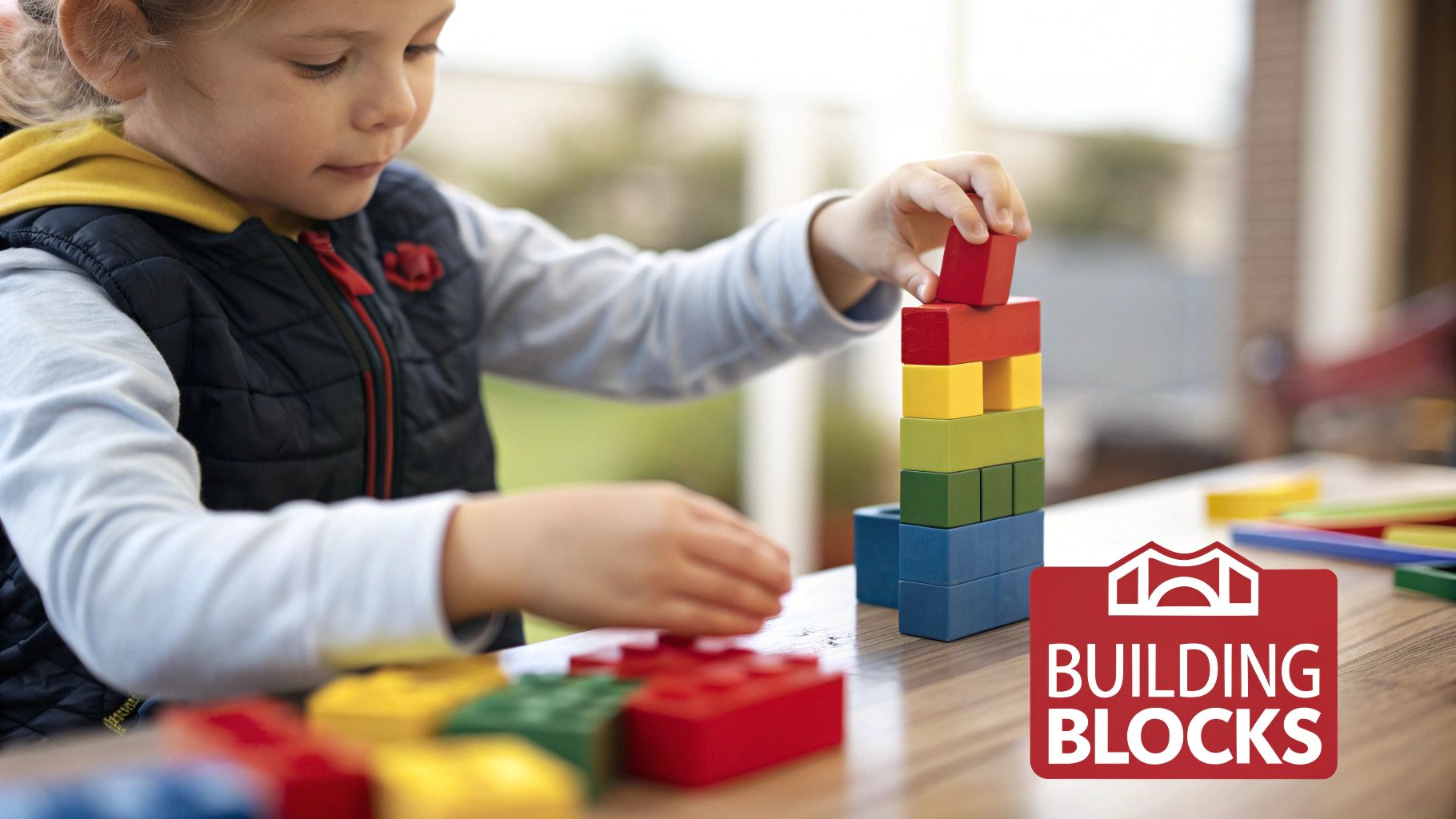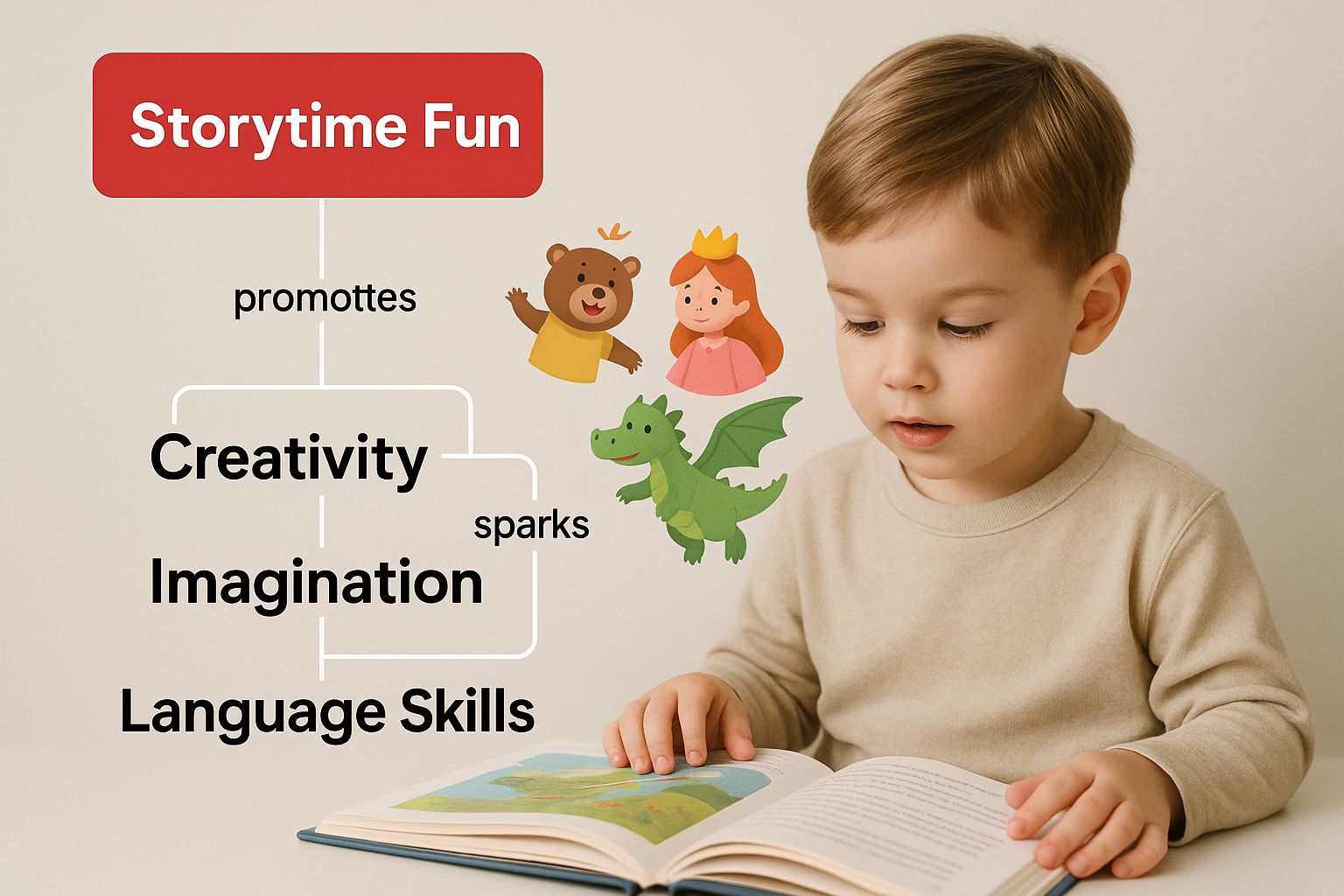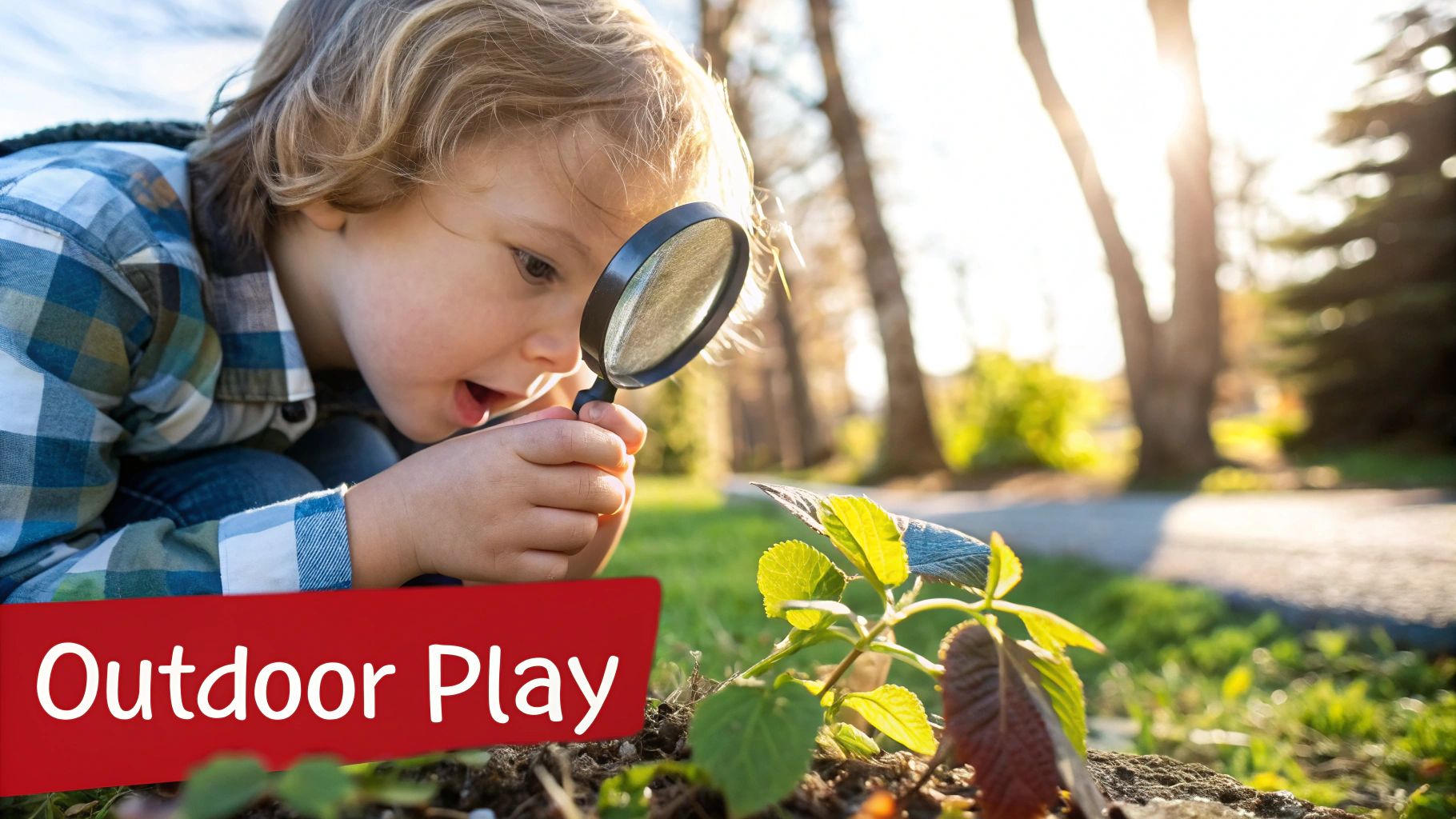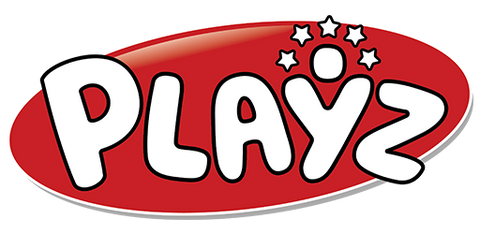
Best Learning Toys for Preschoolers: A Parent's Ultimate Guide
You might be surprised to learn that the best learning toys for preschoolers aren't always the flashiest ones with the most buttons. Often, it's the simplest, most open-ended items—like a classic set of building blocks, a box of colorful art supplies, or a good old-fashioned puzzle—that truly spark a child's imagination and get their problem-solving gears turning.
These are the kinds of toys designed to meet key developmental milestones without being overwhelming. They invite your child to explore, create, and think for themselves.
Why the Right Toys Matter for Your Preschooler
When you're picking out a toy for your preschooler, it feels like you're just trying to keep them busy for a little while, right? But it's so much more than that. You're actually making a direct investment in their rapidly developing brain.
Think of each toy not as a simple distraction, but as a specialized tool for learning. This kind of purposeful play is what builds the foundational skills your child will carry with them into school and beyond—everything from tackling problems and thinking creatively to getting along with others.
This guide will help you see toy shopping as a powerful opportunity. We'll show you how to transform ordinary playtime into a launchpad for your child's success, so you can skip the guesswork and make choices that truly feed their natural curiosity.
Actionable Insight: Toys as Building Blocks for the Brain
A preschooler's brain is like a busy construction site, constantly forming new connections that will serve as the foundation for all future learning. The best learning toys act as the essential materials for this incredible project.
For example, when a child is stacking blocks, they aren't just building a tower. They're running a mini-experiment with gravity, balance, and spatial awareness—the very fundamentals of physics and engineering! This hands-on approach is how kids learn best. Toys give them the perfect medium to explore, test out their theories, make a few mistakes, and try again, all in a safe and fun environment. It's a process that builds not just knowledge, but also crucial life skills like resilience and self-confidence.
Key Takeaway: Play is the highest form of research. It’s through play that children learn about themselves and the world around them, turning curiosity into discovery.
Fueling a Lifelong Love of Learning
The right toys can also spark a passion for learning that sticks with a child for life. When playtime is fun and engaging, kids start to see learning itself as something exciting and positive. A simple science kit that lets them mix colors or a set of magnetic tiles for creating wild structures can ignite a genuine sense of wonder.
This philosophy is the heart of discovery-based learning, where kids are encouraged to explore and figure things out on their own. If you're interested in diving deeper, you can explore the principles of discovery-based learning in our detailed guide.
Ultimately, the goal is to find toys that invite your child to be an active participant in their own education, turning every play session into a joyful adventure.
Understanding How Preschoolers Learn and Grow

Before you can pick the perfect toy, it helps to get a glimpse into the incredible world of a preschooler's mind. The years between three and five are an absolute explosion of growth, and knowing what's happening under the hood makes it so much easier to see why certain toys click while others fall flat.
Think of it like this: you wouldn't hand a five-star cookbook to someone just learning to boil water. Matching a toy to a child’s developmental stage makes learning feel like an adventure, not a chore. It’s how you nurture specific skills with every puzzle piece they snap into place or every wobbly tower of blocks they build.
The demand for toys that do just this is huge. In fact, the global market for educational toys hit an estimated USD 54 billion in 2023. A massive chunk of that is driven by parents of toddlers and preschoolers who see the power of play. If you're curious, you can dig into the full research behind these numbers and see the data for yourself.
The Big Three Developmental Areas in Preschoolers
Preschool development isn't just one thing—it’s a mix of physical, mental, and social growth all happening at once. The best toys don't just focus on one area; they support all three, sometimes in the very same activity.
- Fine Motor Skills: This is all about the small, precise movements in their hands and fingers. Real-world example: Think about the focus it takes to hold a crayon, thread a bead onto a string, or carefully fit a puzzle piece into its spot. That’s dexterity in the making.
- Cognitive Development: This covers how kids think, explore, and solve problems. It’s the budding logic they use to figure out a shape-sorter or the memory they flex during a matching game. It’s the “aha!” moment.
- Social-Emotional Learning: This is a big one. It’s where they learn to understand their own feelings, share with friends, and communicate what they need. A play kitchen or a set of dolls becomes a mini-stage for practicing teamwork, empathy, and negotiation.
Key Takeaway: Choosing a toy is like choosing a key for a specific door in your child's development. The right key opens up new worlds of understanding, skill, and confidence.
These developmental areas don't work in isolation; they’re completely intertwined. Imagine two kids building a block tower together. They’re using fine motor skills to stack the blocks, cognitive skills to plan how high they can build it without it toppling, and social skills to share the blocks and work as a team. That’s the magic of a great toy—it gets multiple parts of the brain and body working together seamlessly.
For more ideas on how to foster this kind of all-around growth, check out our guide to creative learning activities for preschoolers. At the end of the day, the goal is to provide tools that make learning feel like the most exciting game in the world.
Matching Great Toys to Essential Preschool Skills
Alright, we’ve covered the key developmental milestones for preschoolers. Now for the fun part: let's connect those goals to the actual toys you see on the shelf. This is where the rubber meets the road, showing you how something as simple as a set of blocks or a tub of playdough can build real, tangible skills.
Thinking this way helps you choose toys with a purpose. Instead of just grabbing what looks colorful or fun, you can pick items that specifically strengthen the areas you want to encourage, whether that's fine motor control, creative thinking, or those first steps in problem-solving. It’s about turning playtime into a powerful, skill-building session.
Skill Focus: Building Minds with Construction Toys
When a preschooler grabs a handful of blocks, they're not just stacking. They’re suddenly an architect, an engineer, and a city planner all rolled into one. Toys like LEGO Duplos, magnetic tiles, or even classic wooden blocks are fundamental for developing spatial reasoning. They get a hands-on lesson in balance, symmetry, and cause-and-effect every time they figure out why one tower stands firm while another comes crashing down.
These toys are truly the cornerstone of early STEM learning. It’s no surprise the learning and education toys market is booming, expected to hit USD 82.4 billion by 2029. This growth is largely fueled by parents looking for toys that foster this kind of cognitive development.
Skill Focus: Unleashing Creativity and Fine Motor Control
Never underestimate the power of art supplies. A humble set of chunky crayons, some washable paint, and a pair of safety scissors do far more than just create masterpieces for the fridge. These activities are absolutely critical for strengthening the small muscles in a child’s hands and fingers—the very same muscles they'll need to learn how to write.
On top of that, art is a sandbox for emotional expression and creativity. There are no "wrong" answers, which is a huge confidence booster and encourages kids to think in new and imaginative ways.
Storytime is another fantastic way to spark creativity and have fun, as this image shows.

When kids get lost in a good story, characters and ideas leap off the page, fueling their imagination for hours of play.
Key Takeaway: The most effective learning toys are often the most open-ended. They don't tell a child what to do; they ask, "What can you create?"
Skill Focus: Nurturing Social Skills Through Pretend Play
Role-playing toys—think play kitchens, doctor kits, or a chest full of dress-up clothes—are absolute goldmines for social-emotional growth. When kids engage in imaginative play, they step into different roles, giving them a chance to practice empathy, negotiation, and communication. They learn to take turns, share responsibilities ("You be the chef, I'll be the customer!"), and work through disagreements.
This kind of play is basically a rehearsal for real-life social situations. It lets them explore complex emotions and see the world from different points of view, all within a safe and playful space. To see how these activities build lifelong skills, you can check out our guide on how to develop problem-solving skills in young children.
To help you see these connections at a glance, here’s a quick breakdown of which toys support which skills.
How Different Learning Toys Support Preschool Development
| Toy Category | Primary Skills Developed | Example Activities |
|---|---|---|
| Building Toys | Problem-Solving, Spatial Awareness, Fine Motor Skills | Stacking blocks, constructing with magnetic tiles, connecting LEGOs |
| Art Supplies | Creativity, Fine Motor Control, Self-Expression | Drawing with crayons, painting, cutting with safety scissors |
| Puzzles & Manipulatives | Logic, Hand-Eye Coordination, Shape Recognition | Fitting puzzle pieces, sorting beads, lacing cards |
| Pretend Play & Dress-Up | Social Skills, Empathy, Language Development | Playing house, acting out scenarios with a doctor kit, creating stories |
This table can be a handy reference next time you're trying to find that perfect, skill-building toy for your preschooler.
Our Top Picks for Preschool Learning Toys
Walking down the toy aisle can be totally overwhelming. How do you choose from a sea of brightly colored plastic? The secret is to look past the packaging and focus on what a toy actually does. The best learning toys for preschoolers are the ones that target specific, powerful skills.
We’ve put together a list of our top picks, not just by brand, but by the developmental superpowers they unlock. Think of it less as a shopping list and more as a guide to matching the right toy with your child's natural way of learning.
https://www.youtube.com/embed/wqH9MkIy_Fg
For each category, we’ll break down exactly how a child uses the toy to grow and learn. We'll also give you an honest look at the pros and cons to help you find the perfect fit for your little one.
Best for Budding Engineers (Problem Solving & Spatial Skills)
Got a kid who loves to build, stack, knock things down, and figure out how they fit together? Construction toys are a must-have. These are the building blocks (literally!) of early STEM skills, teaching spatial reasoning, balance, and cause-and-effect in the most hands-on way possible.
Our Pick: Magnetic Tiles (like Magna-Tiles or PicassoTiles)
Practical Example: Picture your preschooler carefully clicking two square tiles together, then adding a third to see if their structure stands. They’re learning about structural integrity without even knowing it. When they build a ramp for a toy car and see how fast it goes, they're running a real-time physics experiment.
- Pros: Incredibly versatile and open-ended, sparking creativity and genuine problem-solving. The satisfying "click" also supports fine motor development.
- Cons: High-quality sets can be an investment, and having just a small collection might limit creation size. Losing pieces is almost inevitable.
Best for Creative Storytellers (Social & Language Skills)
If your preschooler has a wild imagination and is constantly making up stories or acting out scenes, then toys that encourage role-playing are your best friend. These aren't just for fun; they are powerful tools for building social-emotional intelligence, language skills, and empathy.
Our Pick: A High-Quality Play Kitchen or Doctor Kit
Practical Example: When a child pretends to cook a meal for their stuffed animals, they’re practicing sequencing ("First, we chop the carrots!"), learning new vocabulary, and exploring nurturing behaviors. A simple doctor kit lets them process their own experiences with checkups in a safe, controlled way, helping them build empathy by caring for a "patient."
Key Takeaway: The magic of pretend play lies in its ability to turn everyday objects into a stage for learning. A simple cardboard box becomes a rocket ship, and a toy stethoscope becomes a tool for understanding empathy.
This kind of play is absolutely essential for developing a strong emotional vocabulary and learning how to navigate different social situations. For a deeper dive, our guide on educational toys for 3-year-olds has even more ideas for this crucial age.
Best for Critical Thinkers (Logic & Fine Motor Skills)
What about the little one who is methodical, loves a good challenge, and enjoys seeing a task through from start to finish? For them, puzzles and other hands-on manipulatives are perfect. These toys sharpen logic, improve hand-eye coordination, and build the kind of focus that will serve them well in school and beyond.
Our Pick: Wooden Puzzles with Varying Complexity
Practical Example: You can start with simple peg puzzles and gradually introduce more complex jigsaw-style ones. The simple act of turning a piece over and over to find its correct spot is a masterclass in spatial awareness and fine motor precision. Best of all, that feeling a child gets when they finally snap the last piece into place gives them a real, tangible sense of accomplishment, building both confidence and resilience.
Here’s a quick comparison to help you choose:
| Toy Category | Best for Kids Who... | Core Skills Nurtured |
|---|---|---|
| Magnetic Tiles | Love building and experimenting | Spatial Reasoning, Engineering |
| Play Kitchens | Enjoy imaginative, social play | Language, Empathy, Storytelling |
| Wooden Puzzles | Are patient and love solving problems | Logic, Fine Motor Skills, Focus |
Ultimately, the best learning toys for preschoolers are the ones that connect with their natural interests while gently pushing them to try something new. By focusing on the type of play a toy encourages, you’ll find something that delivers lasting value long after the initial excitement wears off.
How to Choose a High-Value Learning Toy: A Buyer's Checklist
Walking into a toy store can feel overwhelming. The aisles are packed with flashy boxes, all screaming about the amazing developmental benefits they offer. But cutting through the noise to find a truly great toy is easier than it looks. It's not about the bells and whistles; it's about asking the right questions.
The biggest shift in thinking is this: instead of focusing on what a toy does, ask yourself what it allows your child to do. Does it put them in the driver's seat, or does it do all the work for them? The best toys are like a blank canvas, inviting your preschooler to become the inventor, the artist, and the storyteller.
Prioritize Safety and Durability
First things first: a toy has to be safe. Here in the United States, always look for toys that meet the standards set by the Consumer Product Safety Commission (CPSC). This is your assurance that it’s made from non-toxic materials and doesn't have any hidden hazards.
Durability is a close second. Let's be honest, preschoolers are not gentle. A toy needs to survive being dropped, banged, and dragged on countless adventures. Well-made wooden toys and high-quality, sturdy plastics are almost always a better investment than a flimsy toy that’s destined for the trash after a week.
Look for Open-Ended Potential
The real magic of a fantastic learning toy lies in its open-ended value. This just means it can be used in a ton of different ways, growing and changing right along with your child's imagination.
Key Takeaway: A toy's true value isn't measured in how many features it has, but in how many ways a child can play with it. Simplicity often sparks the most complex and creative play.
Real-world example: Take a simple set of rainbow-colored blocks. Today, they're a skyscraper. Tomorrow, they’re a fence for toy animals. Next week, they might be colorful "food" in their play kitchen. That kind of versatility is what keeps a toy at the top of the toy box for years, not just a few days.
It’s clear parents are catching on. The preschool toys market was valued at around $10 billion in 2023, with a huge part of that growth coming from families actively seeking toys that build real skills. If you're curious about the numbers, you can explore the full market report.
This trend has also fueled the rise of toys focused on science, technology, engineering, and math. To see how these specifically help, check out our guide on choosing the right STEM toys for kids. By keeping safety, durability, and open-ended play in mind, you can feel confident you're choosing the best learning toys for preschoolers—the ones that actually deliver on their promises.
Frequently Asked Questions About Preschool Learning Toys

Walking down the toy aisle can feel overwhelming, and it’s natural to have questions. Let's clear up some of the most common ones I hear from parents, so you can feel great about the toys you bring home.
How many learning toys does my preschooler actually need?
It’s a classic question, and the answer is probably fewer than you think. When it comes to learning toys, the golden rule is quality over quantity. A carefully curated collection of open-ended toys—think classic building blocks, some basic art supplies, or a few challenging puzzles—will do far more for your child’s development than a mountain of battery-operated gadgets that only do one thing.
Actionable Insight: Try a toy rotation. Box up a portion of their toys and store them away for a few weeks. When you bring them back out, they feel brand new, reigniting your child's interest without you having to buy a single new thing.
Are expensive educational toys better than simple ones?
Honestly, not usually. A toy's real value isn't tied to its price but to how well it engages a child's mind and hands. The best learning toys for preschoolers are often the simplest ones.
Key Takeaway: A toy’s value isn't in its price tag but in its potential. Simple, classic toys like wooden blocks or playdough are often more beneficial because they empower children to be creative problem-solvers.
Think about it: many flashy electronic toys just walk a child through a pre-programmed sequence. A humble set of blocks, on the other hand, offers infinite possibilities. It can become a castle, a spaceship, or a bridge—all powered by your child's imagination.
When should I introduce STEM toys to my preschooler?
Here's some good news: you’ve probably been doing it all along without even realizing it. So many foundational preschool toys are actually the building blocks (pun intended!) of STEM.
Every time they stack blocks, they're learning about engineering and balance. When they fit shapes into a sorter, that's geometry. Even splashing around during water play is a hands-on physics lesson!
At this age, the goal isn't to get them to memorize formulas. It's about nurturing their natural curiosity. Look for toys that let them build, sort, count, and see what happens when they try something new. That’s STEM in action.
Ready to find toys that make learning an adventure? At Playz, we design science kits, building sets, and creative toys that spark curiosity and turn playtime into discovery. Explore our collection and see why #KidsLearnBestThruPlayz.
Discover the perfect learning toy for your preschooler at Playz!
